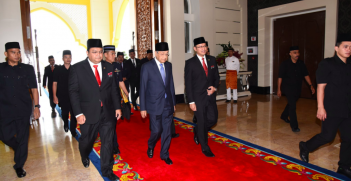India’s Defence Exports and Global Power Aspirations

India is increasingly using arms exports as a strategic tool to enhance its diplomatic influence, strengthen regional partnerships, and assert itself as a rising global power. The current government has linked defence manufacturing with foreign policy to build national capacity, counter rivals like China and Pakistan, and elevate its international standing.
In the evolving landscape of global power politics, defence capabilities have become a critical component of national influence. Beyond the elements of soft power and other inducements, countries leverage arms exports as a strategic tool to shape alliances, exert geopolitical influence, and enhance their economic standing. For India, a nation striving to become a great power, arms exports have emerged as a key instrument of foreign policy, strengthening its diplomatic influence and regional partnerships. To this end, the Modi government has strategically linked defence policy with foreign affairs, utilising arms exports to shape regional security.
Countries with advanced defence industries wield greater power in global affairs, using arms trade as a tool for geopolitical leverage. In the US, for instance, arms transfers were employed to achieve its politico-military objectives during the Cold War. One achievement in this area was to make NATO countries and non-NATO states like Japan and South Korea dependent on its weapons and defence technological exports. This allowed the US to not only influence these countries in geopolitical contexts but also serve Washington’s defence interests, like gaining access to their military facilities, while also contributing to greater deterrence.
As the above example illustrates, supplier states use arms exports to create dependencies and strengthen geopolitical leverage, while recipient states seek to enhance their security and technological capabilities. A patron-client relationship forms because the supplier provides spare parts and technical know-how to the recipient state, which increases the influence of the supplier. The US uses military hardware to enhance the security of its allies. In return, the recipient states must consider American interests in taking geopolitical steps. For instance, the militaries of the UAE and Morocco have benefited greatly from US military hardware, and in return were more willing to agree to the Abraham Accords, established under the first Trump administration. They received advanced weapons, Barak 8 missiles, and drones worth US$3 billion.
Arms sales also bring economic dividends. The state benefits from weapons sales, bringing in foreign capital, while reducing the costs of weapon production. The economies of scale illustrate that when production increases, combined with international sales, it lowers the per-unit cost of manufacturing. Overall economic growth improves because of employment creation and a reduction in the balance of payment differences in imports and exports of arms. Consequently, investments in research and development grow, which drives innovation. Recognising this, India has increasingly integrated defence manufacturing and arms exports into its broader foreign policy framework as it strives to be acknowledged as a major power in the 21st century.
The development of a robust arms infrastructure requires three essential pillars: a strong defence industry, domestic procurement procedures, and research and development. India is working to establish a competitive arms industry. Defence research and development initiatives, such as the Technological Development Fund and the iDEX scheme, have played a crucial role in promoting innovation and the indigenous production of defence equipment. New Delhi has also established two new defense industrial corridors in Tamil Nadu and Uttar Pradesh, which will be crucial in producing, testing, and facilitating weapons. Meanwhile, the defence budget has risen to US$74 billion, up from $30 billion in the period between 2014-25. This rise in spending shows India’s commitment to establishing a robust defence industry.
Through arms exports, India appears eager to establish its footprint in regions that align with its geopolitical interests and counterbalance rival states. For instance, New Delhi’s sale of BrahMos supersonic missiles to the Philippines, and ongoing negotiations with other Southeast Asian nations (Indonesia, Vietnam, and Malaysia), are a part of India’s Act East policy aimed at countering China. In other areas, such as the Caucasus, India has been openly supporting Armenia against Azerbaijan by selling weapons (as this aligns with New Delhi’s position on the Kashmir dispute, which is in line with India’s official stance on the matter). This diplomatic but also military-industrial position also contributes to pushing back against Pakistan, which is supporting Azerbaijan.
Under Prime Minister Narendra Modi India has adopted a Machiavellian approach to foreign policy, prioritising national interests and more tangible outcomes for security. This position advocates for national development and enhancing global influence over ideological rigidity. This includes a push for an indigenous defence industry, aimed at reducing reliance on foreign suppliers while expanding India’s geopolitical footprint. As India’s economic and technological capacity grows, its ambition to become a leading arms exporter aligns with its broader diplomatic objectives, which include gaining access to emerging technologies through tech-diplomacy. All this is to employ new technologies to augment the capability of the defence industrial base, enabling India to manufacture cutting-edge defence equipment attractive to foreign customers.
India’s more tangible defence and diplomatic interests are innately defined by a conservatively religious world view, one in which hierarchy is paramount. India seeks to secure its place among top-tier powers by increasing its national capacity and global diplomatic reach to gain prestige. Dr Subramanyam Jaishankar, India’s Minister of External Affairs, advocates a departure from passive diplomacy, urging confidence and boldness in power competition to secure its interests.
India is poised to achieve self-sufficiency in weapons production. It aims to reduce weapon imports and increase exports, thus enhancing its prestige and capability. However, under the pragmatic foreign policy approach of Modi and Jaishankar, a nexus between arms exports and foreign policy is forming. This will help India not only buttress its strategic reach and influence but also counterbalance its rivals, China and Pakistan, which reflect India’s aspiration to become a great power.
Kumail Mehdi is a Research Assistant at the Center For International and Strategic Studies, Islamabad, Pakistan.
This article is published under a Creative Commons License and may be republished with attribution.





